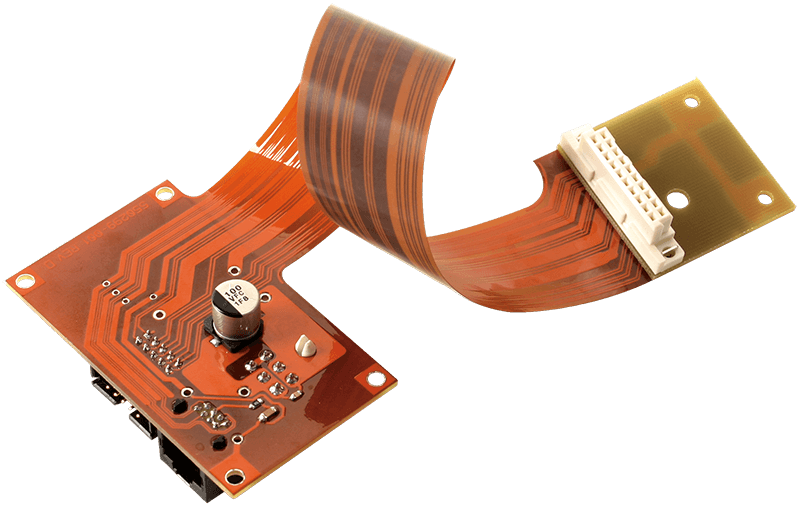Flexible Printed Circuits
What are Flexible Printed Circuits?
A flexible printed circuit, also known as a flex circuit, consists of a metallic layer of traces, usually copper, bonded to a dielectric layer, usually polyimide. Thickness of the metal layer can be very thin (<.0001″) to very thick (> .010″) and the dielectric thickness can vary from .0005″ to .010″. The metal can be bonded to the dielectric using an adhesive, but gaining in popularity are “adhesiveless” laminates that offer great performance and thermal advantages. Other types of bonding such as vapor deposition can be used to attach the metal as well.
Because copper tends to readily oxidize, the exposed surfaces are often covered with a protective layer; gold or solder are the two most common materials because of their conductivity and environmental durability. For non-contact areas a dielectric material is used to protect the circuitry from oxidation or electrical shorting.
Flexible printed circuits are sometimes confused with printed circuit boards (PCBs), but there is a significant difference between the two in terms of design, functionality and fabrication. Additionally, while their name suggests otherwise, today’s flexible printed circuits are actually not commonly manufactured using printing; most use photo imaging or laser imaging as the pattern definition method instead.
Flexible Printed Circuit Design Advantages
The fact that a flexible circuit board can be bent, folded, and configured in just about any shape or thickness imaginable gives the designer tremendous options when creating an electronics package. Size and space limitations are far less of an issue than traditional design using hardboard circuits. Assembly and handling costs can be significantly decreased because the entire interconnect system can be built as one integrated part. Add in All Flex’s ability for component assembly and testing, and supply chain management becomes greatly simplified.
This tremendous flexibility in design choices leads to electronic packages being smaller, lighter, and more functional.
Flexible Printed Circuit Fabrication
There are two basic categories of processes for manufacturing a flexible printed circuit: Subtractive and additive.
In a subtractive process, one starts with a solid area of metal, and the unwanted areas of metal are removed to form the traces. Screen printing and photo imaging are the two most common processes used for defining the circuitry pattern.
In an additive process, one starts with a bare dielectric layer and the metallic traces are added only where needed to form the circuit. The conductive layer can be printed, plated, or deposited in a variety of manners.
The subtractive processes are more common because they are more robust and cost effective, and they allow greater choices in final product configuration. The flexible circuit boards created by the additive process have less current-carrying capability and environmental resistance than circuits created by the subtractive processes.
Flexible Printed Circuit Finishing and Assembly
Surface finishing is usually required to assure the flexible printed circuit surface is ready for subsequent bonding such as SMT assembly, wire bonding, or pressure connector insertion. Nickel or gold, tin, silver, and solder are excellent metals for this purpose. Organic coatings can also be used to protect the copper until the bonding process, which dissolves the material away.
There are countless assembly options for a flexible printed circuit. In addition to electronic components and connectors, a variety of electrical or mechanical devices can be attached to a flexible circuit. The circuit can also be easily bonded to a curved surface or formed to any 3 dimensional shape. With proper construction a flex circuit can handle dynamic flexing, making it the ideal interconnect solution for electronic packages that connect moving or rotating parts.
The true potential of a flexible printed circuit may only be limited by the imagination of the designer! Contact an All Flex design engineer today to learn more about the amazing possibilities a flexible circuit board can offer.
